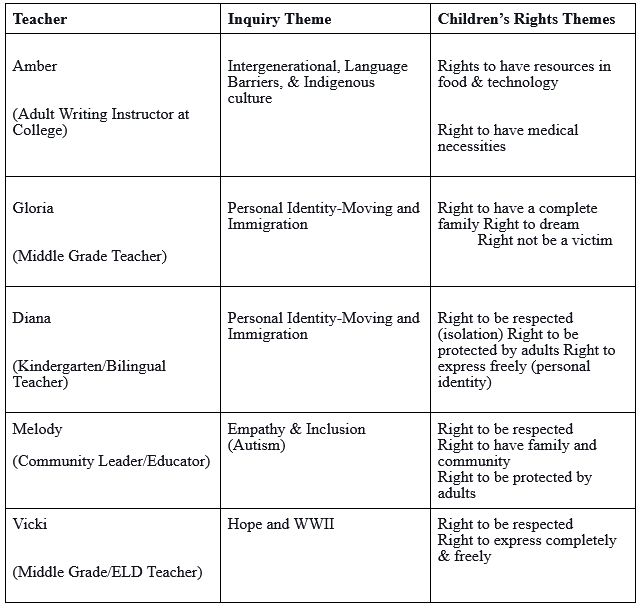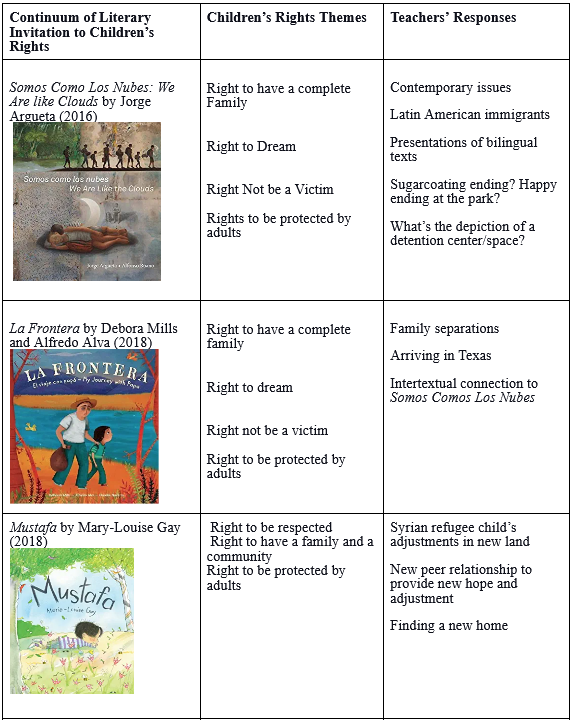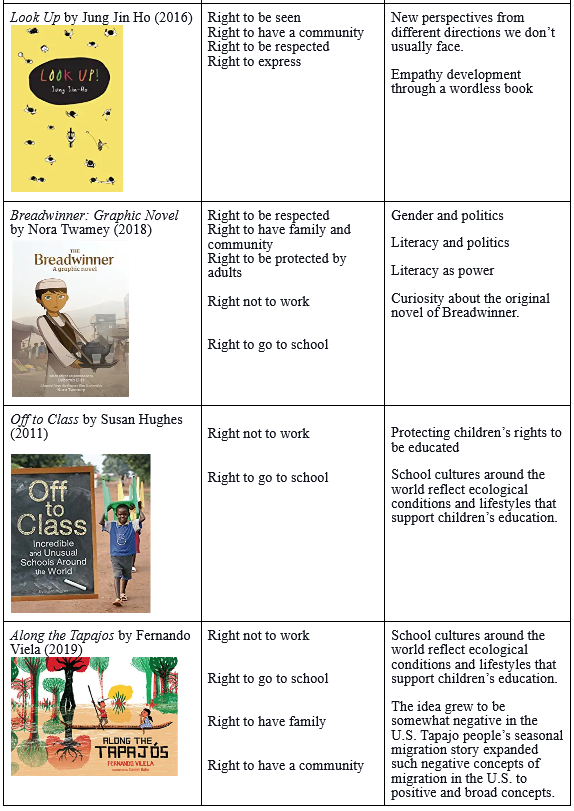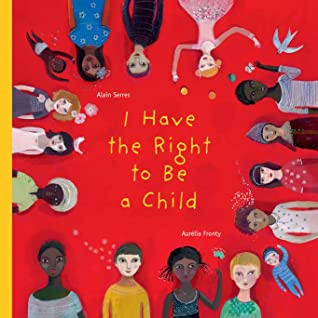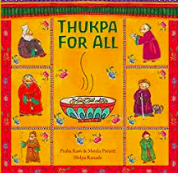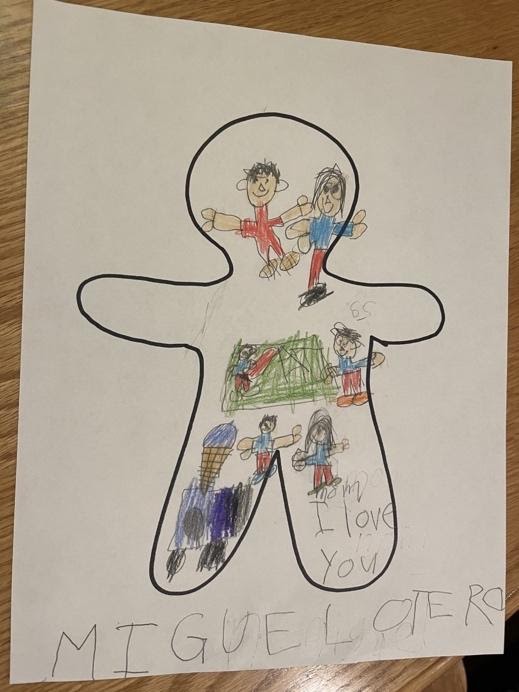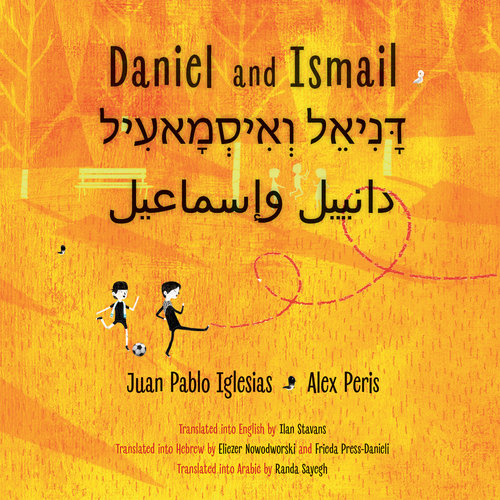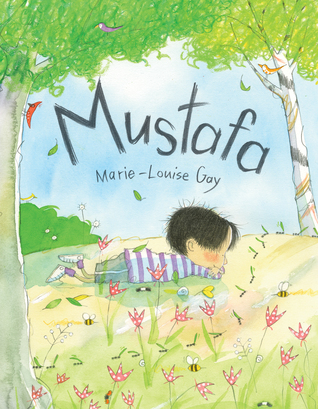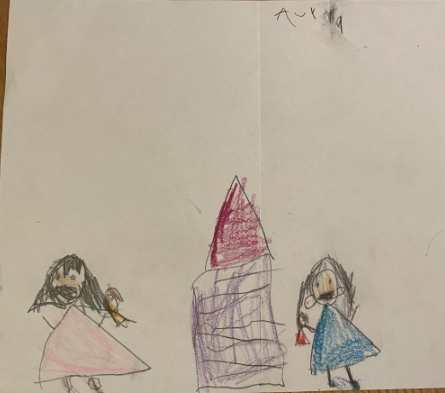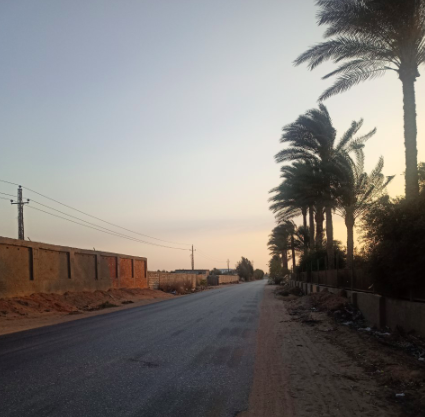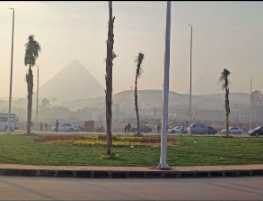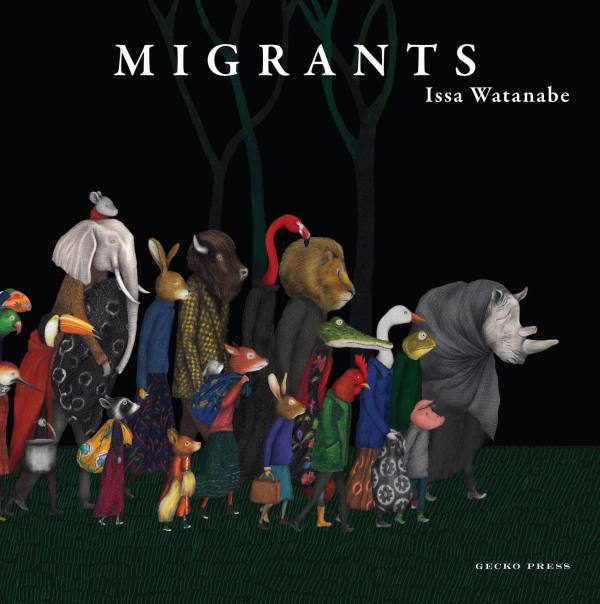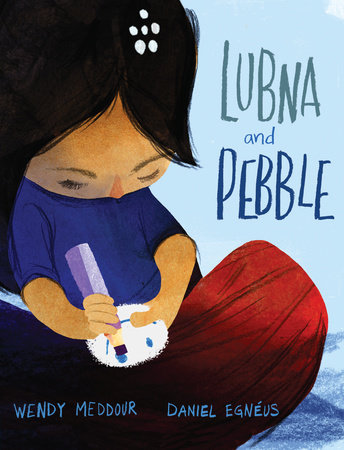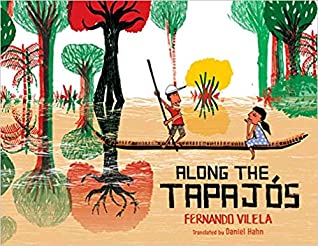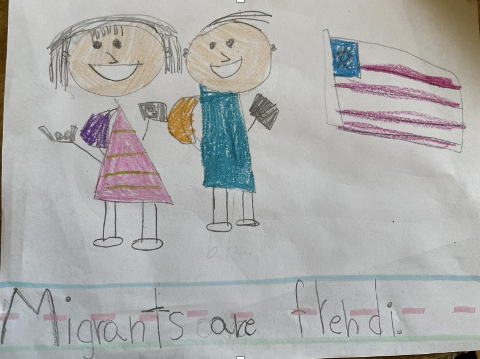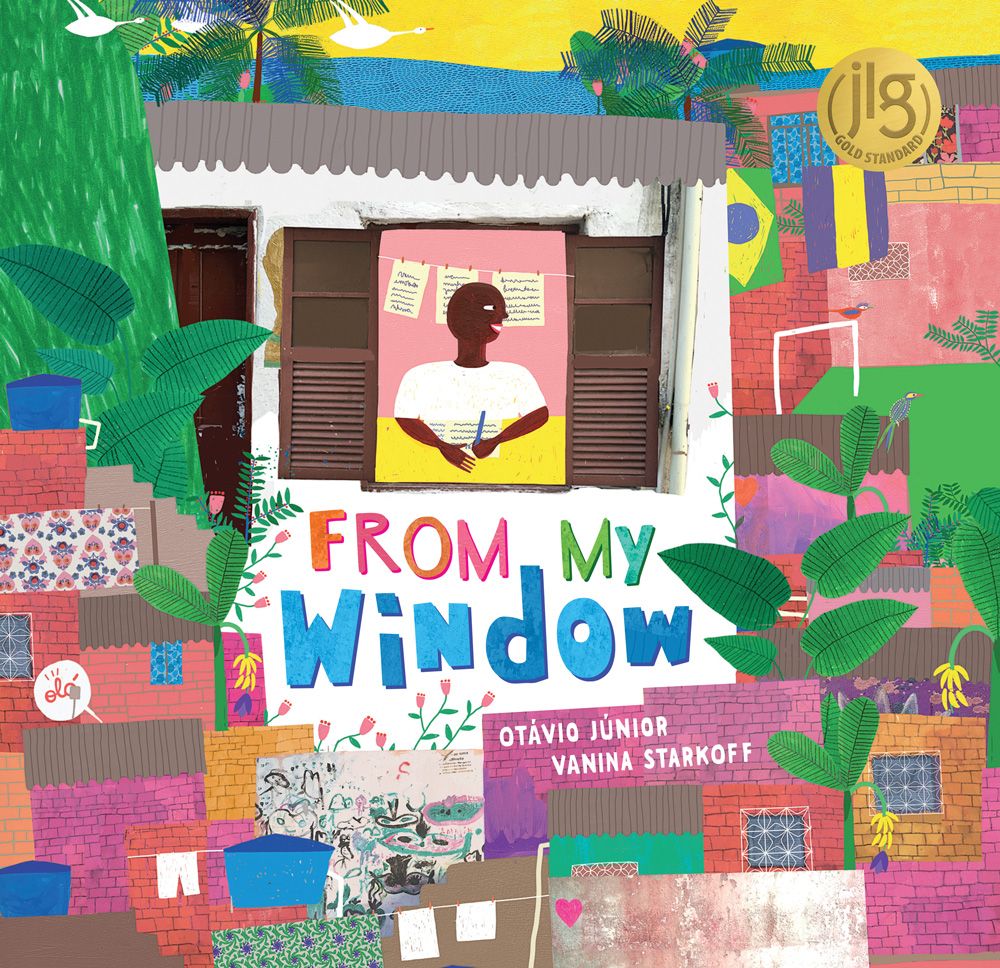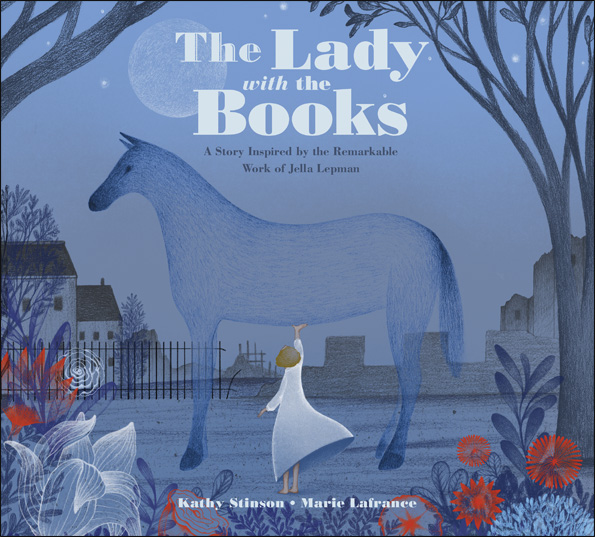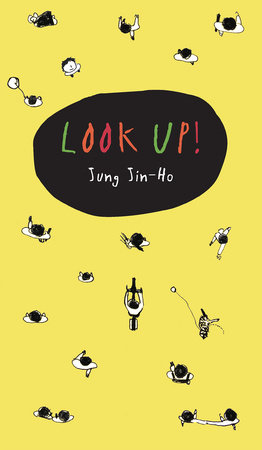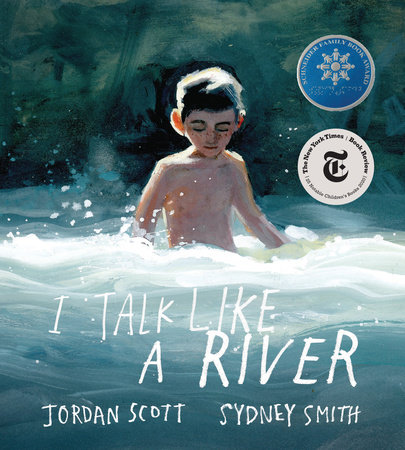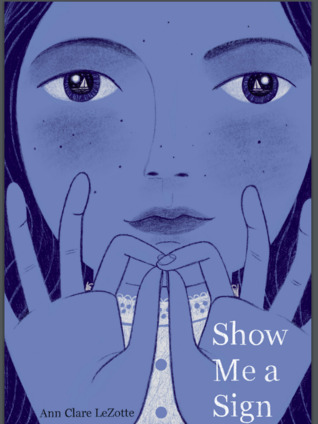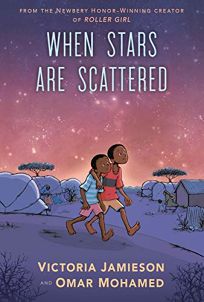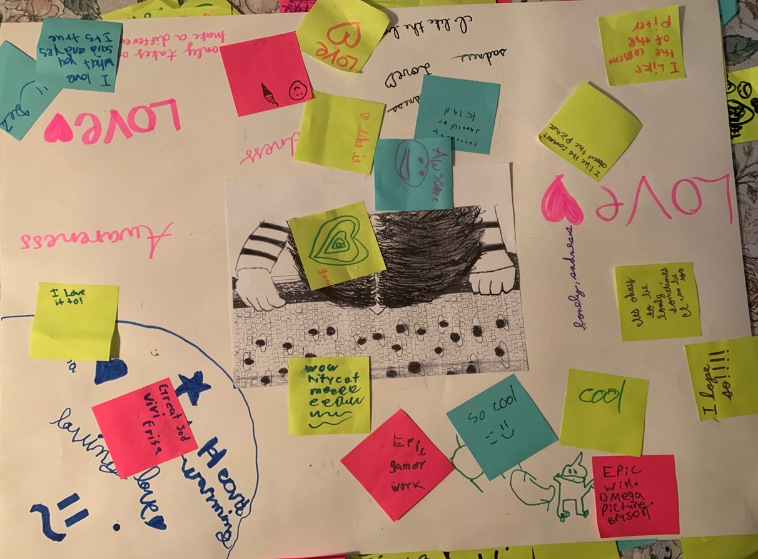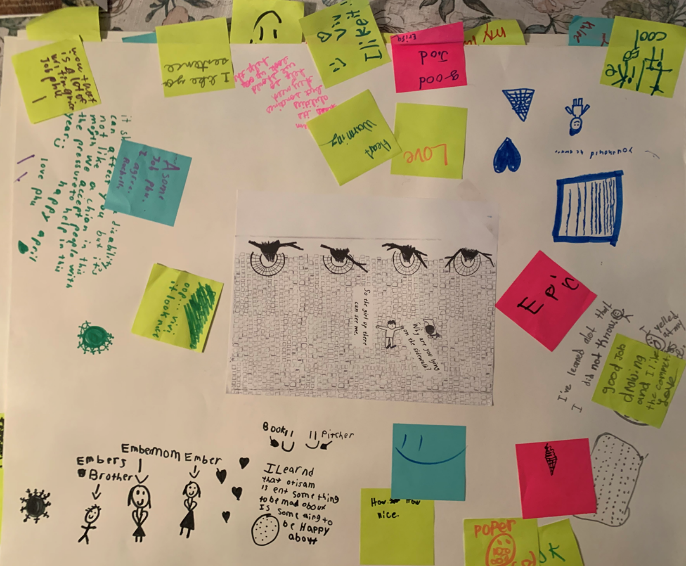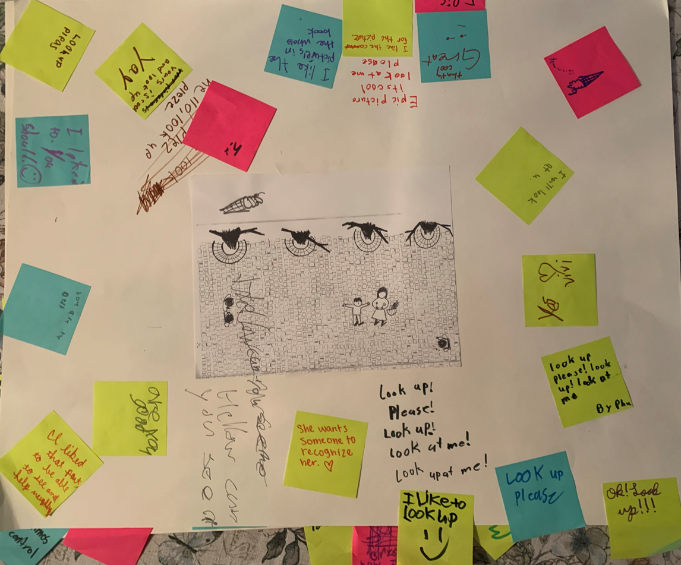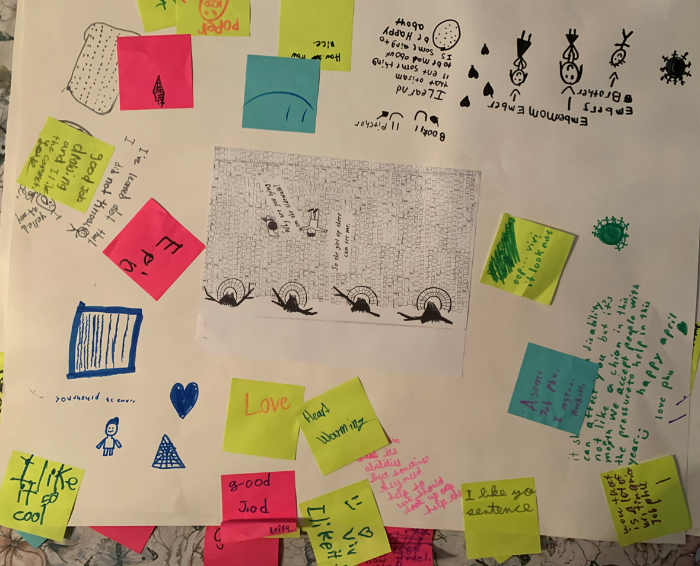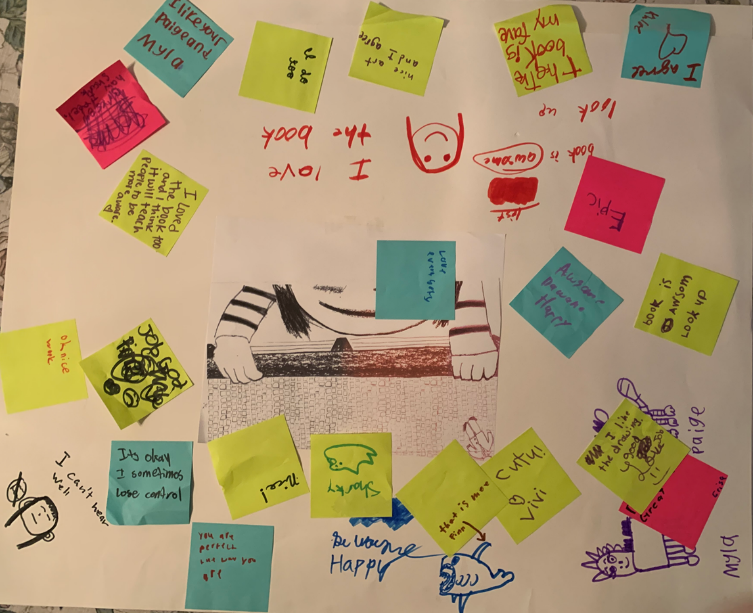Exploring Children’s Rights through a Global Literacy Community in the Land of Enchantment
Yoo Kyung Sung, Diana Botello, Amber Gordon, Melody Magor-Begay
Our Process as a Global Literacy Community by Yoo Kyung Sung
I have many wishes in teaching graduate literacy courses. My first wish is to continue reading global and international literature together as a group after a semester ends. My other wish is to continue to meet even though we live on different sides of New Mexico. This literacy community group was born as a way for these wishes to come true.
Albuquerque is the only large city in the state of New Mexico. The Land of Enchantment is the state nickname. Albuquerque metropolitan areas are formed around the city of Albuquerque, which means there are many remote towns and schools where teachers are locally connected. For example, the world-famous tourist city, Santa Fe, is the capital of our state and yet is still considered a small town from which people commute to Albuquerque by train or car. The teachers who formed the global literacy community of the Land of Enchantment live in different regions in New Mexico, yet we all met through graduate courses where they read a range of children’s literature.
Five classroom teachers living in different locations had a common interest in having a rich dialogue with other teachers as members of a learning community. If the pandemic had not happened, I might have recruited teachers in the Albuquerque Metro areas so that I could continue what I normally do at in-person meetings–eye-contact, laughter, snacks, book browsing, and activities. It was hard to imagine forming a group without these regular agendas. Surprisingly, the COVID-19 situation that was repeatedly described as “unprecedented” became one of the good things that happened to us. Being in different locations couldn’t stop us because we located our meeting space by utilizing virtual discussion tools (i.e. Zoom and Padlet) and continued our celebration of spatiality.
This format and group took a lot of courage for all of us. When COVID-19 began, it was hard to know the best solution for teaching. To be honest, nobody could anticipate what would happen to students and schools. However, six members joined the literacy community and five members stayed till the end. Soon virtual spaces and virtual dialogue grew to be a new normal practice for teachers, and kept nurturing our growth, leading to an appreciation of the literacy community. When teachers felt disconnected from their usual school community and from colleagues and students due to social distances, the pandemic turned out to be a wonderful opportunity to stay connected with teachers in different schools through having collective dialogue where we read, taught, shared, reflected, and grew together beyond our physical locations.
This literacy community includes teachers in various locations. Three teachers live in Northern New Mexico in cities like Farmington and Taos that are a 4-to-6 hour drive away from Albuquerque. We also include a teacher in South Valley near Albuquerque metro areas, yet South Valley has its own unique spatial identity and regional history from Albuquerque. One teacher is in Albuquerque. Different community locations offered diverse perspectives and cultural backgrounds along with school cultures that supported our book discussion. A wide range of areas of specialties and grade levels from a junior college writing teacher, middle-grade literacy teachers, an early literacy bilingual language teacher, and a community parent educator/leader enriched our learning.
In this vignette, I reflect on the literacy community members’ different needs, the role of a monthly study group, and the creation of text sets. The purpose of this reflection is to think about how a literacy community leader can support members. The journey of a literacy community is somewhat ambiguous until we hit the (adventurous) road and move forward as if our journey is like a living thing that is spontaneous, responsive, reflective, unexpected, entertaining, emotive, and challenging.
Articulating My Interests with the Anchor Text
Some of our meetings were both fun and hard because of the feeling of indecisiveness. It was fun to decide what we would do, yet it was not easy because we were shaping what we were to do without being sure of our plans. The beauty of the literacy community was that we planned as we experienced. As a leader, I proposed children’s rights as the leading theme for our group, thinking that children’s rights as a theme would allow us to rethink the sociopolitical landscape of New Mexico. We could unfold a wide range of social issues through the theme of children’s rights, including immigration issues, bilingual and biliteracy learning, inequality of community resources, poverty, and many more. Specifically, the pandemic situations that brought unprecedented problems in shortages of resources, materials, and life essentials could have great potential for us to consider teaching implications with children’s literature because of the strong relevance of books with children’s rights. The ambiguous nature of the group inquiry theme, children’s rights, allowed us to connect sociocultural issues to our teaching of literacy and literature, which mirrors layers of our world.
The first step was reading the first anchor book, I Have the Right to Be a Child (Serres, 2012). An anchor text is a cornerstone book (Sung et al., 2017) that the literacy community members expanded to the concept of children’s rights like tree branches from the tree trunk. This poetry picturebook unpacks the concept of children’s rights through a young child’s narratives and language. We chose I Have the Right to Be a Child as the first anchor text because of its accessibility to the concept of children’s rights and because it helped us to learn about children’s rights. I Have the Right to Be a Child allowed each member to choose a specific type of children’s rights for their teaching. Selecting different types of children’s rights for their teaching helped members reflect on their teaching and units. The early meetings in this journey created the central space where teachers shared their choice of topics related to the children’s rights theme. While they explained what and how they chose in relation to the anchor text, I Have the Right to Be a Child, each member made sense of their teaching practice to work around a children’s rights inquiry and inspired each other. Table 1 indicates each member’s choice of children’s rights that they used to plan their school year 2020-2021.
Choosing an anchor text so that everybody has the same book was helpful for a smooth start to our literacy community. I added several more anchor texts as we proceeded in our literacy community. Along with the anchor texts, assigning a small task, such as selecting sub-themes, helped teachers reflect and think of their themes as inspired by the anchor text, I Have the Right to Be a Child. Sharing what they thought of the anchor text and how they were going to adopt the ideas from the book helped us understand each other’s teaching purposes. I invited teachers to use Epic Books, which is a digital book collection that allows teachers free access so that they could utilize Epic Books for their virtual teaching. At the beginning of the literacy community gathering, half the members had used Epic Books and the rest didn’t know about this tool. The Epic collection was also a great resource for us to prepare for our upcoming meetings. Assigning a book to read for each meeting helped teachers browse a range of children’s books in various genres and formats (i.e. videos and audiobooks). The book choices that we read and shared by utilizing EPIC Books for our meetings helped us think about children’s rights in diverse contexts. Teachers had numerous opportunities to think about their text sets and supported their text set choices for students later in our journey. The assigned readings supported our monthly meetings based on our discussion focus.
Supporting Teachers’ Text Sets
The literacy community members needed a range of supports as they planned their text sets. After they chose their sub-themes related to children’s rights, we read different supporting texts that helped us continue discussing children’s rights. Some members made changes in their teaching focus as we read more literature on children’s rights. I also noticed teachers’ early choices of children’s rights evolved through theme-driven thinking like a circle–empathy, hope, community, protection, etc (Table 1). Before they finalized their text sets, I introduced international children’s literature. Because of the common rhetoric around multicultural children’s literature as diverse books or culturally responsive children’s texts at their schools, teachers interchangeably used the term multicultural literature with global literature. Introducing specific book awards helped them to recognize different types of children’s books beyond culturally responsive and diverse books. One major list was the Outstanding International Books (OIB) by USBBY and the Schneider Family Award by American Library Association (ALA). These two awards helped them to understand the difference between international books and multicultural children’s books that are often labeled as diverse books. In addition, the Tucson Festival of Books (TFOB) virtual book festival provided resources to several teachers. They broadened their book repertoires by adding graphic novels, poetry books, and more from TFOB.
Although teachers, in general, are encouraged to use diverse children’s books by their schools and school districts, teachers’ resources and access to multicultural and global books are not as developed as I thought. OIB recognizes international children’s books that were first published outside of the U.S. and then republished in the U.S., and award books by ALA that recognize different kinds of literary excellence and criteria became resources for choosing their text sets of children’s rights. For example, Melody found a great book list from the Schneider Family Award that recognizes strong books with representations of children with disabilities and special needs. Her theme was empathy around children with special needs (e.g. autism). Starting with anchor texts and deciding together on monthly picturebooks and The Breadwinner graphic novel for our regular meetings seemed to support teachers in reflecting on and planning their teaching. Two other anchor books, Along the Tapajós and Off to Class, were helpful as we choose more international children’s literature while exploring the theme of children’s rights.
Facing Challenges and Identifying Changes
Through their vignettes, the members of the Global Literacy Community of the Land of Enchantment share stories of their journeys. This vignette is my story and includes the realization that things didn’t go as I expected. First, the text sets were more variable than we thought they would be. Teachers carefully chose their text sets based on our discussions, book readings, and idea exchanges among the members; however, not all books in the set were usable. Chapter books take a long time to be used widely with students and some teachers used several books more than the rest of the text set. Mixing picturebooks with chapter books for all age groups might help teachers use their text sets widely and fully. Mixed formats of picturebooks, chapter books, and graphic novels would be useful for hybrid classes as well as online and in-person teaching. Diana shared parents appreciated the picturebooks on migration and the themes of children’s rights, especially because picturebooks are visually powerful.
Second, teachers had different paces with their text set adoptions. School districts and school leadership have certain expectations of teachers’ goals. Supporting teachers to be creative by pairing school materials with their text sets was essential. Checking in with teachers who teach different grade levels would help in seeing how they use their text sets. Teachers in different grade levels have different needs and challenges that they deal with. Unless I checked with them, they felt somewhat awkward about not using the entire text set. Allowing for different spaces would be helpful in providing efficient support.
Looking Back and Moving Forward
Teachers may have had doubts when we began our journey about whether it was a good idea to start a literacy community and to make a commitment for an academic year when things were already crazy. It felt hard and uncertain enough with virtual classrooms and online teaching. It was like wearing a mask when it is already hot in summer. These feelings of doubt and uncertainty didn’t last long. We enjoyed reading wonderful global and international children’s literature with each other. Having our family members, including pets, at home while we were attending a zoom meeting grew normal. Sometimes we had unexpected guests join our meeting on the screen– a cat acting like a kitten, a hugging child, and a barking dog. It isn’t always the best situation, but it worked. Sometimes teachers were not feeling well, yet they were still there over the computer screen. Yes, the pandemic has been hard and challenging; however, strong commitment around an appreciation of books and empowerment by rethinking children’s rights through children’s literature took us to a land of enchantment in our hearts.
References
Sung, Y.K., Fahrenbruck., M., & Lopez-Robertson, J. (2017). Using intertextuality to unpack representations of immigration in children’s literature. In H. Johnson, J. Mathis., & K.G. Short (Eds.). Critical content analysis of children’s and young adult literature. (pp.44-60). New York: Routledge.
Children’s Books Cited
Argueta, J., Ruano, A., & Argueta, J. (2016). Somos como las nubes: We are like the clouds. (E. Amado, Trans.). Groundwood.
Gay, M. (2020). Mustafa. Braille Book.
Hughes, S. (2011). Off to class: Students and schools around the world. Owlkids.
Jung, J. H. (2016). Look up. Holiday House.
Mills, D., Alva, A., & Navarro, C. (2018). La frontera: el viaje con papá/My journey with papa. Barefoot.
Tanaka, S., Ellis, D., Doron, A., Breadwinner Canada Inc, Cartoon Saloon (Firm), & Mélusine Productions. (2018). The breadwinner: A graphic novel. Groundwood.
Serres, A., & Fronty A. (2012). I have the right to be a child. (H. Mixter, Trans.). Groundwood.
Vilela, F. (2019). Along the Tapajós. (D. Hahn, Trans.). Amazon Crossing Kids.
A Kindergarten Journey: Gaining a Deeper Understanding of Ourselves and Others through Exploring Migration by Diana Botello
In the midst of a pandemic, somehow the devotion to teach still prevailed. The times of handshakes, hugging, and getting together seemed so far away. Rather, it was a time when technology took over our classrooms, playgrounds, and meetings. For a bilingual kindergarten teacher like myself, it seemed close to impossible to imagine learning happening under such conditions. Not only was age a factor for students, but my job to teach two languages got much harder. Teaching students how to read, write, and speak in both English and Spanish is a job I take very seriously. Working as a bilingual teacher at a Title I school I see parents who reflect my own family. Parents who work countless hours at minimum wage jobs, who experience discrimination and racism from not speaking English “the right way.” But I also see students whose lack of English has made them insecure and silent. Nonetheless, these parents are the most respectful, caring, and devoted to their children’s education than any other parents at the school. That is because they know what a good education can mean for their children. Being an immigrant to the United States has taught me just how valuable education is. Just how valuable being bilingual can be. And like these parents, I am devoted to giving each student the education they deserve. Despite the hard times the world was living.
Even with all the pressure, stress, and anxiety I saw a light at the end of the tunnel. This light came from the smiles of students, smiles which were made possible from the help and support of their parents and grandparents. These family members were the same ones who sat next to them each day as they logged into my class and made sure they ate breakfast, had everything they needed to learn, and were focused in class. With them in mind, I wondered how to incorporate students and their families into my lessons.
Through the help of my literacy group and our discussions regarding the topic of “Children’s Rights,” we were able to pinpoint specific rights which were relevant to students. These rights came from the book I Have the Right to Be a Child by Alain Serres (2009). Being in a bilingual classroom, I often have students or guardians who are from different countries. I began to think about a theme that I would carry out through lessons with my class. This sub-theme of children’s rights relates to the Migration theme. The rights I focused on were:
- Be respected
- Be protected by adults
- Express myself completely freely
I took a particular interest in this topic because I am an immigrant to this country. It was important for me that students and their families knew where I came from. The topic of Migration could lead to class discussions about culture, language and most importantly, social justice. In an article, Kathy Short (2009) uses a curriculum framework to support students in their intercultural understanding. “This framework highlights multiple ways of engaging with international literature to support children’s critical explorations of their own cultural identities, ways of living within specific global cultures, the range of cultural perspectives within any unit of study, and complex global issues” (p. 3). Following this same framework and discussing the topic of Migration from multiple books for the rest of the semester helped create a safe environment in my classroom; a safe environment that would inspire myself and students’ guardians to tell our own migration stories. Within a few weeks, we were able to have conversations about topics that were crucial to understanding global issues.
Identity: What makes us happy?
Before starting with the topic of migration, it was important that students learn more about themselves and their classmates. We first read Thukpa for All by Praba Ram and Sheela Preuitt (2018). After reading, as a class we created a cultural x-ray (Short, 2009) that was an outline of a body to represent the main character. Inside, we drew identity aspects such as: what made him different, what he valued, and what made him happy. Once this was completed, each student made their own cultural x-ray. I simply asked, “What makes you happy?” Kindergarteners said things like:
- “My mom”
- “My family”
- “My sister”
- “My dog”
- “My grandma”
- And on and on
The cultural x-ray was an outline of their bodies to which they added “the values and beliefs that they hold in their hearts” (Short, 2009, p. 4). With their drawings inside their cultural x-rays, I saw the value each drawing had for them. What they drew is what made each of them different and what made them happy. Students then shared their cultural x-rays with the class and spoke with smiles on their faces about what made them who they are. I am a strong believer that when students’ self-identities are valued and respected by everyone in the classroom, they reciprocate by respecting other people and cultures. “All learners, adults and children, must explore their own cultures before they can understand why culture matters in the lives of others around them” (Short, 2009, p. 3).
Student: Miguel Otero
“What makes me happy is hanging out with my mom. I like when my uncle takes me to the park and when my grandma buys me ice cream.”
Learning about Others: Friendship
In order for students to learn about migration, it was important that they learned that not all kids are exactly like them. “Students come to deeper understandings about their own cultures and perspectives when they encounter alternative possibilities for thinking about the world” (Short, 2009, p. 6). I decided to read aloud picturebooks about children of different cultures and parts of the world. These were Mustafa by Marie-Louise Gay (2018) and Daniel and Ismail by Juan Pablo Iglesias (2016). By first reading Mustafa, students learned that there are kids in the United States that come from different countries. Mustafa’s story also showed them that sometimes people don’t move from one country to another by choice, rather, because of danger. In this story students noticed the different traditions others have as well as how important it is to be friendly.
Friendship played a huge part in our conversation. With this concept fresh in their mind, I read Daniel and Ismail and discussed how their friendship happened even with so many differences and people against them. I explained that in friendships there are often differences in religion, ways of dressing, and even ways of thinking. Regardless, when people have shared interests and they are honest and caring towards one another, then friendships can surpass anything.
For this lesson, I asked students to think of a friend that was different from them. The difference could be because they come from another country, they have different beliefs, traditions, ways of dressing, etc. I asked them to draw their friend, explain what they would do if they were together at that moment and what made them different.
Student: Aurora Hernández
“Es mi amiga de México. Ella no vive aquí, pero a veces voy a visitarla. Ella es diferente porque solo habla español.”
(This is my friend from Mexico. She doesn’t live here but I go visit her sometimes. She is different because she only speaks Spanish)
With this lesson, students learned that although there are people who come from different parts of the world, they bring something special with them. That can be their language, food or traditions. In order for students to learn to appreciate this more, I decided to invite a friend of mine to join our virtual meeting. This friend was Nader Magdy from Egypt. He walked the streets of Egypt and showed students the roads along with the stores and different forms of transportation. He even showed us a wedding where we were able to listen to the music, hear his conversations with others and see how they danced and dressed. Students and their families were delighted to have had this experience. “We worked to integrate the stories, languages, lifestyles, and ways of learning from many cultures” (Short, 2009, p. 6)
Migration: Why do people move from place to place?
To go with the theme of migration, I chose these three books from the Outstanding International Books from USBBY. An international book is “used to describe a book published or distributed in the United States that originated or was first published in a country other than the U.S.” (USBBY). I wanted to give students an understanding of different lifestyles and situations that led people to move and so chose Along the Tapajós by Fernando Vilela (2015). I also chose Lubna and Pebble by Wendy Meddour (2019) to incorporate an understanding that moving can involve seeking refuge from danger and how it is important to be in a safe place. In these two books, students saw yet again the importance of being protected by adults. After reading and discussing these books, I decided to tell them my own migration story. Sharing that I came to the United States at only 8 years old and walked through a desert impressed them. They had so many questions such as:
- “Why did you have to walk through a desert?”
- “Were you scared?”
- “Why did you have to hide?”
All of their questions had answers and as an educator, I was happy that they showed so much interest. Most importantly, I wanted the families to feel that our class meetings were safe environments. Creating this atmosphere allowed some mothers and one grandmother to share where they were from and how they came to the United States. When they shared, I saw the amazement in their child’s eyes because they had not heard that story. Their stories of migration from Mexico and Algeria to the United States were fascinating.
After this discussion, I read Migrants by Issa Watanabe (2020). I chose this book because it connected with not only my own migration story but also that of some parents. This wordless picturebook shows the reality that migrants go through. From the things they take with them to the dangers in their journey. We analyzed the different characters in the book and students noticed how a skeleton always follows the travelers in this book. One student said “that means that someone is going to die.” Although many noticed the skeleton, only one student was able to see the inference. This comment led us to discuss why these forms of migration are dangerous. Also, why people risk their lives to get to a better or safer place. They also saw what the travelers took with them in their journey, such as clothes, blankets and food. We talked about the needs and wants of migrants, such as only taking what was necessary with them.
For this activity, I asked students to think of reasons why migrants are good to this country. They were to draw and write “Migrants are __”
Aislynn Anaya wrote “Migrants are frendi.”
When I asked her to explain her drawing, she said “Migrants need a backpack where they can put all their things. They also need money. They are friendly.”
Right to Be Protected by Adults
Seeing that every student talked about an important adult who made them happy, I saw it as an opportunity to talk about their right to be protected by adults. As a class we discussed how adults can protect them and why they should not be left alone to protect themselves. This was the day we started to talk about their rights. First by reading I Have the Right to Be a Child by Alain Serres (2009) and then focusing on certain ones.
Right to Freely Express Myself
We had a class discussion about another of their rights, which is to freely express themselves. It was important to talk about this right because we discussed topics that they may want to talk more about. I started the conversation by saying:
- “Do you know you have the right to express yourself freely?”
- “What do you think that means to express yourself freely?”
- “Does that mean we break the rules?”
- “In what ways can you express yourself?”
Students were excited to learn that they had the right to express their emotions and feelings. We discussed the various ways they could express themselves like talking, drawing, writing, singing and dancing. I emphasized how important it is to express themselves. I said “When you feel happy, dance and sing! You have the right to express yourself and when you are sad you have to right to be quiet and cry if you need to. No one should take that right away from you.”
Right to be Respected
To finalize our exploration of migration, we discussed a very important right–the right to be respected. I summarized for students everything we had learned about ourselves and different cultures and languages and how there are people from different parts of the world in the United States. I read to them yet again I Have the Right to be a Child by Alain Serres (2009) and emphasized this quote: “I have exactly the same right to be respected, whether I am black, white, small or big, rich or poor, born here or somewhere else” (p. 15). Students and their families learned that it is important to be friendly with people who are different from them. They saw the beauty in every culture and language, and they valued their own. Having finished the lessons, the mothers who were present in each virtual meeting thanked me for teaching their children about migration. The international books we read as well as our discussion about children’s rights helped engage not only kindergarteners but also their parents. As they explained their favorite part and how their child showed interest in learning more about people from different parts of the world. “Children’s engagements with literature have the potential to transform their worldviews through understanding their current lives and imagining beyond themselves” (Short, 2009, p. 10).
In a time of social distancing, somehow countries and people came together. Virtually, students and their families joined and learned about the different circumstances that lead to migration. We shared stories, read international books, listened to music in different languages, and explored the streets of Egypt. My fear of not being able to effectively teach in a pandemic became just a memory because the reality was much better. The light at the end of the tunnel were the smiles from my students and their family members who joined each day. Smiles which grew wider as we explored our identities and shared our personal stories. Smiles welcomed everyone regardless of their language, culture, or background. As a class, we created a safe place right from our computer screens, whether that was in our living rooms, kitchen table or day care.
References
Outstanding International Books. USBBY. (n.d.). https://www.usbby.org/outstanding-international-books-list.html.
Short, K. G. (2009). Critically reading the word and the world: Building intercultural understanding through literature. Bookbird: A Journal of International Children’s Literature, 47(2), 1–10. https://doi.org/10.1353/bkb.0.0160
Reading and Writing about Children’s Rights in a College Writing Class by Amber Gordon
I teach a two-semester writing course at a Hispanic-Serving Institution community college located in Northern New Mexico. My students are adult learners who come to the institution with a wealth of knowledge and life experience but who are considered to be writers who are not quite ready for college level writing. Thus, students need an extra semester to hone their skills prior to entering into what is considered college level writing. I am fortunate to have an entire academic year with them as we practice writing skills the first semester and then, in the second semester, complete the first college level writing course.
During the spring of 2021, while teaching in an asynchronous online classroom environment, I decided to support students with writing prompts related to children’s rights and designed reading discussions around specific texts to help them grow their ideas and spark their curiosity to research this important topic. We read I Have the Right to Be a Child (Serres, 2012), Along the Tapajós (Vilela, 2019), From My Window (Junior, 2020), Mexique: A Refugee Story from the Spanish Civil War (Ferrada, 2020), and The Lady with the Books: A Story Inspired by the Remarkable Work of Jella Lepman (Stinson, 2020). After reading each of these texts we had discussions where students could together explore the meanings of these books. I supported our reading discussions with resources related to the real-world context of the texts. For example, while reading Along the Tapajós (Vilela, 2019) and From My Window (Junior, 2020) we studied the contrast between living along the Amazon and living in a favela in Brazil. In addition to discussing the texts, students also explored what land development, lack of infrastructure, and children’s rights mean in these locations.
We began the semester with I Have the Right to Be a Child (Serres, 2012) and the United Nations Convention on the Rights of the Child (n.d.). These paired texts allowed students to understand that children’s rights are important and need to be intentionally included in our lives as caring human beings. One student said that they enjoyed both texts and “believe strongly that children need to have their rights protected.” Most students reported that they did not know such a convention existed and they were happy to discover it. They discussed the need to empower the children in their lives and to help all children have their basic needs met, viewing this issue as a global priority where they could take action by respecting the views of children around them and making sure that children have space to play and explore their imaginations. Students also challenged these texts, bringing forward their personal stories of inequity in school settings, abuse they have seen in foster care homes, and poverty levels that impact a child’s access to food and clothing.
I found their discussions to be deep and emotionally reflective. I had been worried that students would be exhausted by the stresses of living through the worldwide pandemic caused by COVID-19. Instead, students found vigor in this topic and were eager to learn more and to discover the stories contained in our selected texts.
As we moved forward in the semester, I discovered that students were particularly interested in the places that children live in the world. For a week we explored Along the Tapajós (Vilela, 2019) and From My Window (Junior, 2020). We watched videos on Amazonian basin land rights and life in a favela during COVID-19. We examined maps of these locations and tried to compare them to our river basins and cityscapes. Students enjoyed the artwork of each book. They commented frequently on the use of water and migration as not only a beautiful illustration but also as a way of life that they took as unfamiliar. They felt that Junior’s (2020) book made them feel happy, but they also felt the conflict of a story where a child looked out from a window thinking about and wanting to play.
One student appreciated seeing a book (Vilela, 2019), where a “culture with natural nomadic practices in direct relativity to their environment was represented.” The student was “surprised because they have not observed any modern-day nomadic lifestyles” and admired how the people represented were so “consciously connected to the cyclical climate changes” while understanding that these customs had been “developed over many years and are at risk of being destroyed.” Students also discussed the level of responsibility the characters had in Along the Tapajós (Vilela, 2019) that resulted in risking their lives to save what they loved. This text brought several of them to tears as they considered the perceived realities that some children live. One of my favorite student responses was how “along this riverbed they live a simply yet happy life but it’s because they have a different way of thinking.”
Students were also interested in exploring historic moments where children’s rights were impacted. They wanted to connect these events to current events in order to see how, or if, things had changed over time. We spent a week reading and writing about Mexique: A Refugee Story from the Spanish Civil War (Ferrada, 2020) and The Lady with the Books: A Story Inspired by the Remarkable Work of Jella Lepman (Stinson, 2020). Students described these texts as advocating for the recognition of how children are impacted by living in war zones. One student said “Mexique touches me. Just reading this text reminded me so much of what is going on for our border families.” Another added “it’s like the story keeps rewriting itself.” They were saddened by the way children continue to experience war and separation from their families and felt that both books represented a way for readers to understand how communities can be impacted by war.
While reading The Lady with the Books: A Story Inspired by the Remarkable Work of Jella Lepman (Stinson, 2020), students felt comfort, joy, and love. They remarked that the historical representation of Jella Lepman, founder of the International Board on Books for Young People, was culturally inclusive and nonjudgmental. They felt that this impacted them positively as readers because they could see the critical importance of reading books by authors from other cultures and countries. One said, “I think educational rights were being advocated for in this book and I would recommend this book to readers because it is a book that brought me hope and a little light around the topic of World War II.” Another commented that they really liked this story because it was about “two siblings surviving in a world where they had badly broken their rights and one person made a great impact on them.”
During the semester I found that students connected to themes of environmental protection, as well as the right to play and be educated in a culturally relevant way. Some students expressed that they related to certain texts because they had similar life experiences and were compassionate as they learned about the violations of children’s rights that occur globally in both historical and current contexts. Their essay writing for the course reflected the ways that their independent investigations into children’s rights inspired them to advocate, change, and educate others about this important topic. Students made space in their essay responses to bring in their personal experiences and the experiences of their family members. Additionally, I requested that their family members become part of their peer review group so that they could share these texts and thoughts with whomever they had around them while they were writing. This sharing made their exploration richer and more important to their learning. Based on their reading discussions and essay writing, I know these students have discovered a love and critical need for children’s literature which matters because a book can share so much.
References
United Nations Convention on the Rights of the Child. (n.d.). United Nations Human Rights: Office of the High Commissioner, https://www.ohchr.org/en/professionalinterest/pages/crc.aspx
Children’s Books Cited
Ferrada, M. (2020). Mexique: A refugee story from the Spanish Civil War (A. Penyas, Illus.). Erdmans.
Junior, O. (2020). From my window (V. Starkoff, Illus.). Barefoot Books.
Serres, A. (2012). I have the right to be a child (A. Gonty, Illus., H. Mixter, Trans.). Groundwood.
Stinson, K. (2020). The lady with the books: A story inspired by the remarkable work of Jella Lepman (M. Lafrance, Illus.). Kids Can Press.
Vilela, F. (2019). Along the Tapajós (F. Vilela, Illus, D. Hahn, Trans.). Amazon Crossing Kids.
“It Doesn’t Fit in the Box’: Bridging Acceptance and Children’s Rights with the Community through Global and International Children’s Literature by Melody Magor-Begay
My situation was unique in that I was not limited to one classroom or school setting. The make-up of my population consisted of the Four Corners region in the southwestern corner of Colorado, southeastern corner of Utah, northeastern corner of Arizona, and northwestern corner of New Mexico, which belongs to several Indigenous tribal nations, the largest of which is the Navajo Nation. As an advocate of those families and having two children myself with autism spectrum disorder, my goal and focus was and continues to be a promotor of awareness and acceptance of those with special needs in our surrounding community.
Incorporating Children’s Rights
Since the focus of our Land of Enchantment Global Literacy group’s vision of literature was based on children’s rights; we began our global literature journey with I Have the Right to Be a Child (Serres, 2012) in which the rights presented by the United Nations Convention of Rights of Every Child are presented beautifully. This book was our guide and our foundation, from which each member of our Global Literacy group was then able to connect with their own lesson plans and chosen text sets. We each selected two to three children’s rights to give focus to our selected text sets. The rights I selected consisted of: rights to be respected, rights to have family and community, and rights to be protected by adults; with the underlying theme of empathy and inclusion (especially in the area of autism). Each month our group met via Zoom and allowed our own branches of discovery to connect and grow even further as we found many of our experiences and resources overlapped, binding our work together.
With these goals and children’s rights in mind, I considered how I could implement my selected text sets. The population I was dedicated to work with did not consist of one school and one group, but many community areas. These included the administrators of the Four Corners’ Families with Autism Support Group, a member of the Farmington Municipal School Equity Council, a board member of our local chapter of Equine Therapeutic Riding Remedy Reigns, and an active member of our community through connection to resources in our area from the school districts and City Management of Special Needs programs, such as the All-Abilities Park and Special Olympics.
My goal was not only to create a text set to use in isolated lessons or with one group of students, but one that could be utilized by the community and its members. This is how the underlying theme of empathy across all cultures emerged. Having an intercultural vision of the world around us starts with ourselves. Short (2009) points out we need to “explore our own culture before we can understand that culture matters in the lives of others” (p. 3). Empathy plays a key role in understanding not only our students but ourselves through books as “bridges of understanding to unite children of all countries” (p. 1). Educators are leery of reaching beyond the boundaries of their comfort zones to the unfamiliar, and this is where many students are lost between the cracks–due to a lack of initiative or fear to make connections that are vital. Short states that “when student recognize the cultures that influence their thinking…they no longer see culture as about the ‘other’ but recognize that it is at the heart of defining who they are as human beings” (p. 4). Students need to experience their value authentically, not in an “exotic” manner, but in its true, raw and purest form. Intercultural literature needs to become a living and breathing natural component of our teaching and not a foreign concept presented as another data collection point. What we value becomes a part of us and is a human right that belongs to our students.
Creating My Text Sets
My selected text set grew out of searching through many international book lists, including the Outstanding International Book List from the United States Board on Books for Young People (USBBY) to find books, including Look Up! by Jung Jin-Ho (several copies so I could do book groups as well), I Talk Like A River (Scott, 2020), Show Me a Sign (LeZotte, 2020), and When Stars Are Scattered (Jamieson, 2020).
When beginning my journey with my two children who have autism, I looked high and low for resources that would bring support to a new world I knew very little about. I spent countless hours searching on the Internet, trying to reach out to different agencies, and had many moments that I felt I had truly failed my children. The greatest resource I found was that of people and the discovery of resources through their knowledge. The greatest piece of knowledge and resource I ever received and was reminded of through the process of the Global Literacy Community was a quote my children’s teacher shared with me. Her son was also on the Autism Spectrum and as he became older, he decided that in order to make sense of the world around him, he would look at it as a box that sometimes was not able to hold everything. As he stated to her, and she gave me permission to share his words: “It doesn’t fit in the box, and that’s ok.” I feel as if this perspective is what has not only guided much of my life but could be shared through more than just pamphlets and websites. This connection comes from literature, and especially from Global Literature, which allows us to connect and empathize with those on a similar journey through connecting and binding emotions and prejudices that are not isolated but globally experienced.
A Driving Force and Making Connections
Look Up! became a driving force and the binding for my text set and planning. This powerful text consists of a few words and simple black and white illustrations. The book begins with a child in a wheelchair looking down on a busy city from a high building. All this child can see is an aerial perspective of life below, such as the tops of trees and people’s heads as they attend to their busy lives below. In an attempt to connect with a world this child longs to be a part of, the child shouts down with a request of “Look Up!”–a request unheard and unacknowledged by the narrow vision and perspective of those below. Finally, one person stops and takes the time to look up. Because one person acknowledges this child who so badly wants to connect to the world, others take notice and look up. As each person looks up, a chain reaction occurs and soon there is an entire community of individuals laying on the sidewalk looking up to find a way to connect their lives with this child from an “out of the box” perspective.
This book spoke to me in so many ways; both coming from similar experiences with my own children and as an educator who, after living an autism life and entering the community of special needs because of this life, had seen firsthand how ostracized and forgotten those with disabilities become. Jung Jin-Ho found a way to create an allegory or metaphor through Look Up! that encompassed the heart and soul of every human’s right to matter–rights of awareness and acceptance that many times are not considered or valued, creating a forgotten or invisible people.
With this immense beginning, I branched out looking for similar books with underlying themes of empathy awareness in global literature.
Titles such as I Talk Like a River and When Stars Are Scattered were added because they too showed the power of empathy across all abilities and cultures. I Talk Like a River, a beautifully illustrated text by Sydney Smith and written by Jordan Scott, is from the perspective of a young boy who stutters. He feels very isolated from the world around him and that he is constantly judged about how he sounds when he speaks; so, he feels it is better to stay silent and not even try to connect with the outside world. His only comfort is the river, where he feels he can be himself and can speak freely. This book spoke to my heart, coming from seeing both my own non-verbal children try to communicate with those around them only to be shut down as a result of misunderstanding and fear; empathized so eloquently in Scott’s words, “All they hear is how I don’t talk like them. All they see is how strange my face looks and that I can’t hide how scared I am.” All three of my chosen rights were encompassed and woven throughout this text, especially the rights to be respected and protected by adults.
The young boy’s father tells him that he speaks like the river, proud as it bubbles, whirls, churns and crashes, glistening into smooth and beautiful water. I thought of my son who is not able to greet people in what is considered a normal way or tell me he loves me using traditional words; but uses alphabet letters and chalk to write his feelings and emotions. We are so wrapped up as a community and society in what we think the perspective of normal should look and sound like. When we are faced with unique and “it doesn’t fit in the box” situations, we have a difficult time wrapping our minds around the unique and react defensively by ignoring or shunning the situation or person. I have found this concept to be global, in some cultures more pronounced than others, but still omnipresent.
Developing Global Empathy
A book that was shared in one of our meetings became another foundational book for my work. When Stars Are Scattered illustrated by Victoria Jamieson and written by Omar Mohamed (2020) is a graphic novel that allows a unique opportunity for the reader to enter the true story and life events of Omar and his younger brother Hassan living an uncertain life in Dadaab, a refugee camp in Kenya. Omar’s brother Hassan is nonverbal and considered odd and unintelligent by other community members; a story that is familiar to many living a nonverbal life. Omar finds himself in an internal battle with himself when he has to make the difficult decision to leave his brother behind in order to attend school. Omar’s character encompassed the plea and inner struggle of so many caregivers and siblings of those with special needs–“I’m so tired I can’t do this!” He not only is expected to complete expectations for daily life and survival, but also must protect and care for his only remaining family member, his brother who is lost without him. This feeling of being stretched so thin and also having to contend with the stigma and prejudices of others is felt unanimously globally.
The guilt that accompanies trying to protect and bring about acceptance is a feeling that has no borders or boundaries. The rejection of Hassan as unworthy is a human reaction and infringes on the right to be respected, a right all should be given. Throughout the book I empathized greatly with Omar’s constant struggle of trying to open the world’s eyes to Hassan’s abilities and misunderstood uniqueness; a daily battle that myself and so many others face who care for loved ones with special needs. This story also opened my eyes to “acceptance” itself as a global perspective that needs to be enlightened. Coming to this realization became the catalyst of how vital global literature is in bringing about awareness, acceptance, and change.
I had been asked by several schools to share an interactive lesson that would allow students, teachers, parents and community members to participate in an empathetic lesson on experiencing the world or seeing for a moment through the eyes of someone with autism. I had designed a lesson based on the knowledge of my own life with both my children having autism and from interacting and connecting with many other families and caregivers of those with special needs; a community I had not fully realized existed before. Unfortunately, due to the outbreak of COVID-19, I was not able to share my lesson with an extended group; however, I was able to share and work with my daughter’s fourth grade class, which consisted of twenty-two students, her teacher and the principal of her school. Previously to my daughter’s attendance, her school had never had someone with autism enroll, therefore many biases and stigmas had to be broken, which allowed the door to open to other students with special needs. With this realization, my lesson was centered around Look Up!, hoping for a similar chain reaction.
Walking In My Shoes and Seeing Through My Eyes
My intention was that my lesson could be adapted or modified to meet the needs of others and could also pertain to other special need’s groups, not solely those with autism. I began my lesson with a reading of Look Up!. The students also had copies of the book in hand so they would be able to see the powerful pictures close up. Even though this book is a nearly wordless, it does possess and elicit in readers a great longing to connect to this child calling out and trying to communicate. The child in the wheelchair, unable to get down from the building, earnestly requesting that somebody please take the time to “look up” so the child can see their faces and not just the tops of their heads. This birds-eye perspective was familiar to students and they seemed to empathize with this child’s need to connect. I had to pause on almost every page because I could see students scanning each picture and then immediately sharing what they had discovered–“I see the tops of umbrellas…I see trees…there is like a sea of heads.” One student blurted out, with evident frustration for the child in the book, “Why don’t they look up?” All the students seemed quite relieved when one person finally took the time to look up.
As a chain reaction occurred in the book and more and more people noticed and joined to look up at the child looking down, I asked students what was happening. They noticed the chain reaction that occurred and at the end of the book commented on the large smile that was illustrated on the girl’s face because so many took the time to acknowledge her. They also commented that the only color in the illustrations was at the end after everyone looked up. We continued with an extended conversation and sharing time about the importance of awareness and acceptance and what those two words mean in our lives. We talked about what “the right to be respected” means. Ethan firmly shared that the child looking down had not been respected until “one person stopped and showed the others they needed to stop.” It was “a magical moment.”
The next part of the lesson took this feeling of empathy a step further, as students were given a chance to participate in an empathetic hands-on experience. Each student was given a bag of mixed-up objects including a disassembled puzzle. Their task was to dump the bag out and sort the items into like groups and to assemble the puzzle. The stipulation was that they only had one minute to complete their task. I set a visual timer so they could keep track of their time. As I started the time you could hear the buzz of each group trying to instruct each other on how to complete the task; some groups assigned unofficial jobs of who should sort what and who should put the puzzle together. Some of the students sat silently, letting others take the lead while others had already given up. The teacher circled the classroom as I did and the principal joined in for observation. The timer went off quickly and there was an overall sigh of frustration and disappointment that time had run out, “We didn’t have enough time! Can we have more time?”
I explained that in many cases this is how those with autism feel, they are set a task and because they need to sort and categorize first in their mind, the actual focus of the task becomes impossible. I used the example of their math lessons, that before a person with autism may be able to complete the problems, they have to separate first the subject, then how many problems, the types of problems, where their pencil is, their paper, etc. before they can even consider beginning the actual task. This takes time and before they have even begun, they are expected to be finished. This was eye-opening not only for the students but also for the teacher and principal.
The final part of my lesson involved giving each of the five groups a blank white poster with a selection from Look Up! placed in the middle and a box of markers. Each student was also given five post-it notes. They were to look at the picture or part of the book they had in the middle of their poster and to write either a thought, a quote they liked from the book, words inspired from our reading or previous activity, or illustrate their feelings. After they completed their post-it, they were to attach it to the poster in front of them. When all the groups were completed, the students were then instructed to move to the next group’s poster and comment on one of their classmate’s post-its either with a quote, comment, extension, or illustration. I had started the activity with a reminder that they were not to be hurtful or negative, only supportive to their classmates in their comments and illustrations. This process continued until every group had visited their classmates’ posters and each student had a chance to comment on five other’s post-its. (See “Sticky Thought” Activity Poster).
In the conclusion of the lesson, we had a brief discussion about what students had read and commented on and a time for questions. Alexa asked me if they were autistic because they were deaf in their left ear and we were able to share with one another the difficulties this student had throughout the day as well in completing tasks. Two boys shared that they had Attention Deficit Disorder (ADD) and they too felt they had to take the time to sort and “group in their minds” before they could finish a task. As a parting gift to the teacher and the class I left a text set, including several books I thought would be beneficial to their library, such as I Have the Right to Be a Child, I Talk Like a River, and several copies of Look Up!.
My Eyes Have Been Truly Opened
Throughout the process of our Global Literacy Community, my eyes have truly been opened to the rich resources that are available if only one digs a bit deeper. In nature we tend to grasp at what is at surface level, right in front of us, “at face value” and forget that beneath the surface are the greatest treasures. I feel our Global Community resembles this process in many ways. I have found I am a surface grabber and need to dig deeper to see all the treasure. As we met each month and shared with one another, I felt I was gathering treasure for a resource treasure box. Each person shared their beautiful books and I found myself adding to my collection of global literature weekly.
One particular book that was shared by one of my cohort colleagues was When Stars Are Scattered. I was fortunate to participate in the Tucson Festival of Books in which the author Omar Mohamed and illustrator Victoria Jamieson shared the essence of their book and Omar’s project of Refugee Strong for which he organizes volunteer trips to Dadaab almost every year. He takes books, pencils and lamps for students purchased with funds raised throughout the year. I want to reach out to Omar through his website www.refugeestrong.org to see if our local autism support group and the San Juan Autism Society could also be a support for those with special needs through his program. I am hoping we can explore a way to take action in supporting refugee education in Kenya through our community members.
As part of my selected text set, I also requested several copies of the book Look Up! so I could share this book physically with others, although it is available on EPIC digital library, I wanted it accessible without a subscription to community members involved in the Four Corners Families with Autism support group and those on the Equity council for our local school districts. Galadriel, a mother from Four Corners Families, shared a beautiful experience after reading Look Up!. Her son, who has autism, had joined a local baseball team and when it was his turn to be up to bat, he would not swing until he had completed writing the alphabet in the dirt with his bat. Instead of the other players and families becoming impatient or upset with her son’s batting process, they said the letters with him and cheered him on with each swing.
I placed several copies of Look Up! in the Farmington, New Mexico resource room provided by Farmington Municipal Schools in their main building, as well as copies of other books shared in our Global Literacy Community. This also included the shared books Off to Class: Incredible and Unusual Schools Around the World (Hughes, 2011) and Along the Tapajós (Vilela, 2019); books both depicting the essence of the right to be respected and the right to family and community–to me they are interconnected. Having two autistic children, my life is very unconventional as are many of the families mentioned in both books. The outside world does not always understand or have empathy for my family, and I find myself working harder and harder to bring insight. My children have the right to live life to its fullest just as the families throughout the stories in these books. Through my experiences, my heart and eyes have had to open and I wish they had been illuminated before. Through beautiful works such as these and more and more exposure and sharing of such beauty, I feel the world is well on its way to opening up and allowing these rights to infiltrate and burn brightly. “One size does not fit all.” Being who we are as unique human beings who come from unique situations, having the right to be respected may have to come in different forms.
New Avenues of Learning in Looking to The Future
Unique learning situations may need to be implemented along with unique exposure of needs and the true empathy and consideration of families and communities. Respect can’t coexist with judgement, only perspective and modification. If a family needs to earn their living during the daylight hours, education and support still needs to exist, only at a modified and what may seem as an unconventional time. Our world is large and rights are deserved by all, whether in a school or living in a cave or a treehouse or in family forced to move with the seasons. Schools that follow learners or go to learners is at the very heart of my lesson and vignette and these books exhibit this idea beautifully.
My journey does not end here as there are still so many avenues and connections I intend to make stemming from our Global Literacy Community. Being able to collaborate with colleagues and build a text set that is beneficial in connecting to empathy and in promoting empathy awareness has ignited so much more. From sharing on our Padlet after each meeting, reflecting on each other’s posts and coming together each month to collaborate further through the sharing of our discovered books and corresponding lessons, I see an entirely new chapter of bringing about awareness and acceptance in our educational and extending communities. My future aspirations include the creation of a book group to share the global titles mentioned in this vignette and newly discovered books as well. I would also like to continue to share and put global literature in the hands of our community, such as the Four Corners Families with Autism. I was able to share Look Up! through EPIC in one of our monthly support meetings via Zoom during COVID-19 and it sparked many rich conversations about how awareness and acceptance need to grow in our communities. It was exciting to have a colleague from our Global Literacy Community join us and share that they would also share about our support group with their own community.
Progress has to be accomplished with small steps and empathy makes for a stronger community. In all the books we shared and discovered, these seem to be common themes. Fathoming the unconventional or unknown is imperative for empathy and knowledge to grow, and both are the catalyst and are essential for a stronger community. By reaching out as a member of the Equity Council, participating on boards of All-Abilities initiatives such as our community’s All-Abilities Park and the local chapter of the Remedy Reigns Therapeutic Horsemanship Program and contributing resources such as these rich text sets of global literature, I feel progress can be made. The next steps will be to attempt to connect with Omar Mohamed through his book, reaching out hopefully to other special needs communities, co-host a webinar and family program with The University of New Mexico Center for Development and Disability, and share many of these resources at a Light-it-up Blue event with our community. My goal is to build awareness and acceptance for our special needs community to show that “It doesn’t have to fit in a box…and that is ok.”
References
EPIC (2021). https://www.getepic.com/
Short, K. G. (2009). Critically reading the word and the world: Building intercultural understanding through literature. Bookbird: A Journal of International Children’s Literature, 47(2), 1-10. doi:10.1353/bkb.0.0160
Tucson Festival of Books (2021). http://tucsonfestivalofbooks.org
Children’s Books Cited
Hughes, S. (2011). Off to class: Incredible and unusual schools around the world. Berkley, CA: Owlkids.
Jamieson, V., Mohamed, O., & Geddy, I. (2020). When stars are scattered. New York: Dial.
JIN-HO, J. (2018). Look up! New York: Holiday House.
LeZotte, A. C., & Morstad, J. (2020). Show me a sign. New York: Scholastic.
Scott, J., & Smith, S. (2020). I talk like a river. New York: Neal Porter.
Serres, A., & Fronty, A. (2016). I have the right to be a child. Toronto: Groundwood.
Vilela, F. (2019). Along the Tapajós. Two Lions.
Diana Botello is a bilingual kindergarten teacher at Susie Rayos Marmon Elementary. She completed her Masters in Language, Literacy, and Sociocultural Studies with a concentration in Bilingual Education in December 2021.
Amber Gordon is an Adjunct Writing Instructor and the Training & Development Specialist in the Center for Academic Success and Achievement at the University of New Mexico – Taos.
Melody Magor-Begay was a third and fourth Grade teacher at Kirtland Elementary and is the Administrator of the Four Corners’ Families with Autism Support Group and member of the Equity Council of Farmington Municipal Schools. She completed her Masters of Arts in Elementary Education focusing her final Capstone Project on Living the Questions of Autism: Equine-Assisted Therapy and Empathy.
Yoo Kyung Sung is Associate Professor in The College of Education and Human Sciences at the University of New Mexico in Albuquerque, New Mexico.

WOW Stories, Volume X, Issue 1 by Worlds of Words is licensed under a Creative Commons Attribution-NonCommercial-ShareAlike 4.0 International License.
Based on work by Yoo Kyung Sung, Diana Botello, Amber Gordon, Melody Magor-Begay at https://wowlit.org/on-line-publications/stories/volume-x-issue-1/6/.
WOW stories: connections from the classroom
ISSN 2577-0551

